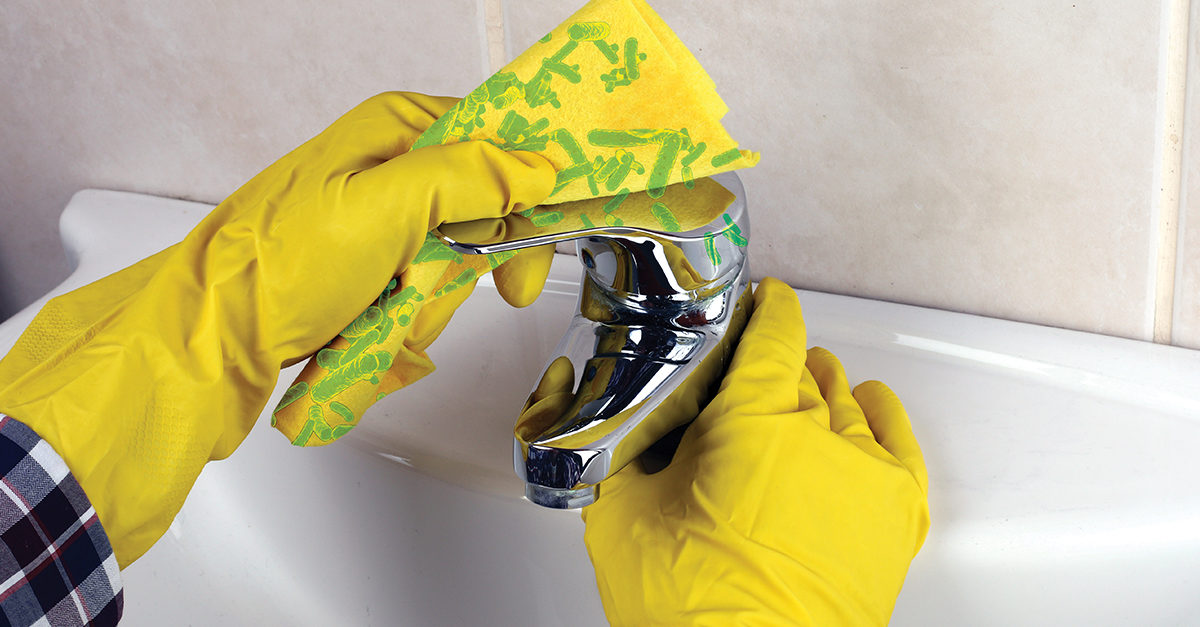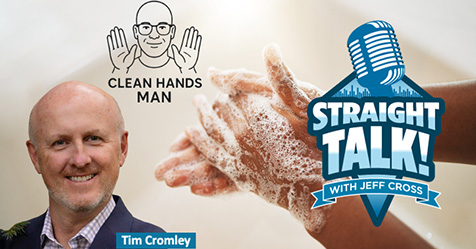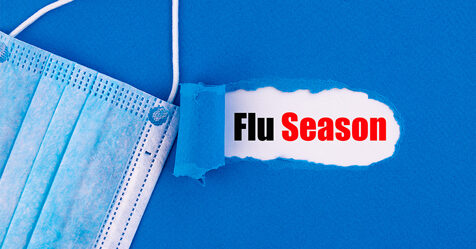You finish cleaning the restrooms in an office building and head to the break room/kitchen area. While it may seem most efficient to transport the cleaning tools you just used from the restroom into the kitchen, taking the extra time to set up new tools is necessary to prevent cross-contamination.
“You never want to use a mop [you used to clean a bathroom] in the kitchen,” says Arely Castellon, a LEED (Leadership in Energy and Environmental Design) green associate with Sparkle Team®, a sustainable building service contractor in Boca Raton, FL.
Cross-contamination is the act of transporting germs and bacteria from one place in a facility to another, and can be done unintentionally during cleaning. For instance, a custodian could wipe down a toilet that was exposed to norovirus and then use the same cleaning tool to wipe down the sinks, spreading the virus. Or a custodian could clean a kitchen sink contaminated with raw chicken debris containing the salmonella virus and then use the same cloth to wipe the kitchen counter. While these may seem like simple mistakes, they could lead to the spread of norovirus or salmonella among a company’s employees who come in contact with those surfaces throughout the day.
A wide range of businesses, from offices and restaurants to hospitals and schools, depend on custodians to maintain a healthy facility for employees and customers. By following three steps, professional cleaners can ensure a building is not only clean, but contaminant-free.
1. Color Code and Categorize
Devise a system to help staff remember to switch their cleaning cloths and tools once they complete a particular task. Castellon suggests using different colored cleaning cloths for different rooms and purposes. “We use microfiber cloths that come in a myriad of colors,” she says.
Microfiber cloths and mop heads come in a minimum of four colors: red, yellow, blue, and green. An importer and distributor of microfiber cleaning products recommends following the British Institute of Cleaning Science’s Colour Chart to clean specific rooms and fixtures.
- Red: sanitary appliances, restroom floors, toilets, and urinals
- Yellow: restroom surfaces, including sinks, towel dispensers, hand dryers, soap dispensers, door handles, and walls
- Green: general food and bar cleanup in non-preparatory food areas, such as lunchrooms
- Blue: areas at low risk of contamination, such as hallways, offices, and classrooms.
If four colors are not enough, feel free to use more to meet your facility’s needs.
Correct cleaning tool storage is crucial to maintaining the separation accomplished by color coding. Ensure the janitor’s closet is well organized with cleaning supplies for each room stored in a separate space. “Using different mops for the kitchen and the restroom won’t solve cross-contamination if the kitchen mop is laying on top of the restroom mop in the closet,” Castellon says.
2. Upgrade Your Tools
In addition to a variety of colors, microfiber cloths and mops offer a unique particle-trapping property. Microfibers have a positive charge that attracts dust, which has a negative charge, according to a report on a case study conducted by the University of Massachusetts Lowell in Lowell, MA. After microfibers attract the dust, which contains dirt and bacteria particles, they hold these particles tightly so they are not redistributed around a room during cleaning.
A case study by the University of California Davis Medical Center in Sacramento, CA, in collaboration with the U.S. Environmental Protection Agency, compared bacteria cultures taken from surfaces after they were cleaned by a traditional wet mop and a microfiber mop. After a wet mop cleaning, surfaces showed a 30 percent reduction in bacteria. After a microfiber mop cleaning, surfaces showed a 99 percent bacteria reduction.
Many cleaning services forgo traditional mops altogether. “The moment a traditional mop head touches the floor, it’s contaminated,” says Tom Morrison, vice president of marketing for a manufacturer of science-based cleaning products. “Then you put it back into the water, contaminating the water and the next surface you wipe.”
Another tool that offers an alternative to mopping is a spray-and-vac system, which dispenses a fresh cleaning solution for each application. Then the system vacuums the solution from the floor, instead of wiping it, eliminating the spread of contaminants from the floor to other surfaces via the cleaning tool.
3. Clean From Top to Bottom
Cross-contamination often begins at high-touch areas, such as door knobs, counters, and railings. Floors are another source for germs and bacteria, with gravity pulling soil and germs to them. Even if your hands don’t directly touch the floor as often as they touch a door knob or other high-touch area, you likely will pick up items that have been on the floor.
A methodological cleaning process works best to avoid missing any areas of a room. Custodians should clean from top to bottom so dust and dirt that isn’t captured in the cleaning tool falls to the floor and is picked up during the final steps. Here are some tips to implement such a process:
Wipe down surfaces first. The U.S. Centers for Disease Control and Prevention outlines a basic cleaning and disinfecting method that involves first wiping down surfaces and fixtures with water and cleaning solution. Castellon’s team follows this approach. “As soon as they enter a room, Sparkle Clean crews put on disposable gloves, spray down all the surfaces, then wipe them down,” Castellon says.
Disinfect second. Next, spray disinfectant on areas that need sanitizing and let it set for 5–10 minutes before wiping it off.
Tackle the floor last. Mop or vacuum the floor from the farthest inside point of the room and out the door, so you don’t clean yourself into a corner. “We mop the floors last, so we’re walking out as we’re mopping, then throw out the gloves as we leave the room,” Castellon says.
One Last Tip
If possible, Sparkle Clean designates one person to clean just the bathroom. “Having designated cleaners for specific rooms makes cross-contamination even less likely,” Castellon says. She explains that cleaners can carry bacteria and germs not only on their tools but on their clothing and hands. Restricting one cleaner to restroom duty is an effective method to keep restroom germs out of lunchrooms and other areas.




